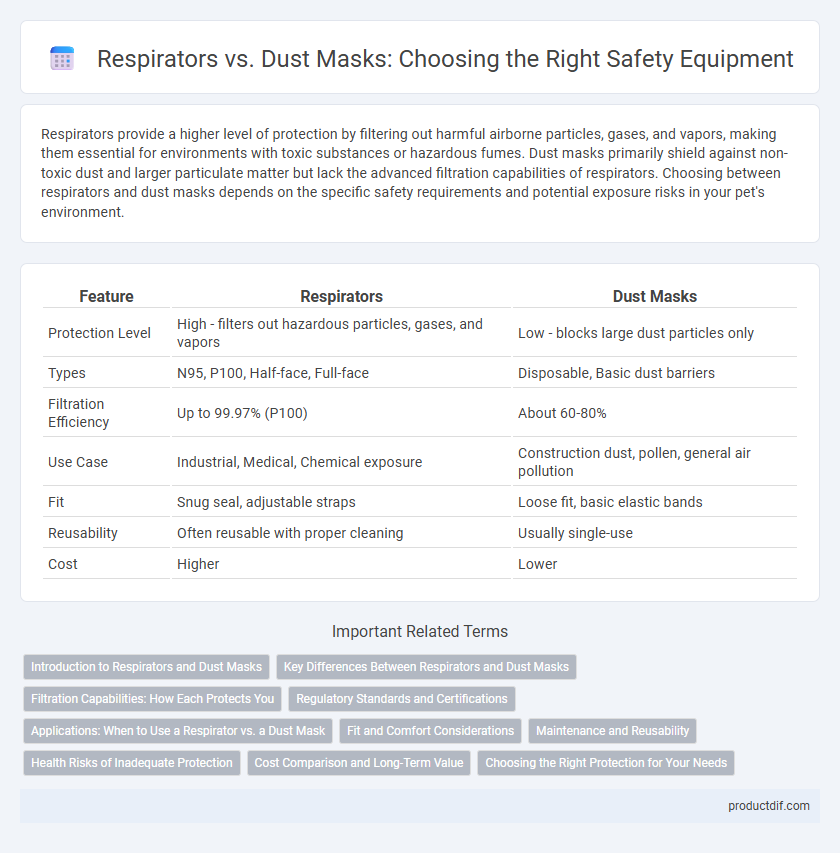Respirators provide a higher level of protection by filtering out harmful airborne particles, gases, and vapors, making them essential for environments with toxic substances or hazardous fumes. Dust masks primarily shield against non-toxic dust and larger particulate matter but lack the advanced filtration capabilities of respirators. Choosing between respirators and dust masks depends on the specific safety requirements and potential exposure risks in your pet's environment.
Table of Comparison
| Feature | Respirators | Dust Masks |
|---|---|---|
| Protection Level | High - filters out hazardous particles, gases, and vapors | Low - blocks large dust particles only |
| Types | N95, P100, Half-face, Full-face | Disposable, Basic dust barriers |
| Filtration Efficiency | Up to 99.97% (P100) | About 60-80% |
| Use Case | Industrial, Medical, Chemical exposure | Construction dust, pollen, general air pollution |
| Fit | Snug seal, adjustable straps | Loose fit, basic elastic bands |
| Reusability | Often reusable with proper cleaning | Usually single-use |
| Cost | Higher | Lower |
Introduction to Respirators and Dust Masks
Respirators provide a higher level of protection by filtering out harmful airborne particles, gases, and vapors, making them essential in industrial and hazardous environments. Dust masks are typically designed to block large dust particles and offer limited protection, primarily suitable for non-toxic dust exposure in everyday tasks. Understanding the difference between respirators and dust masks is crucial for selecting appropriate safety equipment based on specific respiratory hazards.
Key Differences Between Respirators and Dust Masks
Respirators provide a higher level of protection by filtering out airborne particles, including hazardous contaminants like chemicals, gases, and infectious agents, whereas dust masks primarily protect against non-toxic dust and larger particles. Respirators feature a tight seal around the nose and mouth, ensuring minimal air leakage, while dust masks offer a looser fit and are less effective at filtering fine airborne particles. Regulatory standards such as NIOSH certification apply to respirators, guaranteeing performance levels, whereas most dust masks lack formal certification and are intended for basic nuisance-level protection.
Filtration Capabilities: How Each Protects You
Respirators provide superior filtration capabilities by using specialized filters designed to protect against airborne particles, gases, and vapors, offering a higher level of respiratory protection in hazardous environments. Dust masks primarily filter larger dust particles but lack the sealing and advanced filtration mechanisms necessary to guard against fine aerosols or toxic substances. Selecting the appropriate equipment depends on the specific airborne contaminants and the required level of respiratory protection for safety compliance.
Regulatory Standards and Certifications
Respirators are regulated by organizations such as NIOSH and must meet strict standards like N95, N99, or P100 certifications to ensure filtration efficiency against airborne particles. Dust masks, often used for nuisance dust protection, do not typically meet NIOSH certification and lack the rigorous testing required for hazardous respiratory environments. Compliance with OSHA regulations mandates the use of NIOSH-certified respirators in workplaces with harmful contaminants, distinguishing them from standard dust masks.
Applications: When to Use a Respirator vs. a Dust Mask
Respirators are essential in environments with hazardous airborne particles, chemicals, or pathogens, providing a tight seal and advanced filtration to protect against respiratory hazards in industrial, medical, or hazardous material handling settings. Dust masks are suitable for low-risk tasks like sweeping, sanding, or gardening where protection from non-toxic dust and larger particles is sufficient. Selecting between a respirator and a dust mask depends on the level of exposure, particle toxicity, and required filtration efficiency for specific workplace safety standards.
Fit and Comfort Considerations
Respirators provide a secure, tight seal around the face, ensuring superior protection against airborne contaminants compared to dust masks, which typically have a looser fit. Comfort factors such as adjustable straps, cushioning, and ventilation are integral to prolonged respirator use, while dust masks often prioritize breathability but may sacrifice fit stability. Choosing between respirators and dust masks requires balancing effective filtration with wearer comfort, especially in environments demanding extended protection periods.
Maintenance and Reusability
Respirators offer superior maintenance options through replaceable filters and components, extending their usability and ensuring consistent protection against hazardous particles. Dust masks, typically disposable, lack replaceable parts and should be discarded after a single use or when they become damaged or soiled. Proper cleaning and storage of respirators enhance their lifespan and functionality, making them a cost-effective choice for long-term safety equipment.
Health Risks of Inadequate Protection
Respirators provide a higher level of protection by filtering out airborne contaminants, including toxic gases and fine particles, reducing the risk of respiratory illnesses and long-term lung damage. Dust masks, designed primarily for comfort and light dust, fail to adequately block hazardous fumes or microscopic particulates, increasing the likelihood of exposure to harmful substances. Inadequate respiratory protection can lead to chronic conditions such as silicosis, asthma, and occupational lung diseases, emphasizing the critical need for appropriate certification and fit.
Cost Comparison and Long-Term Value
Respirators typically incur higher upfront costs than dust masks but offer significant long-term value through enhanced protection and durability, reducing replacement frequency. Dust masks are cheaper initially but may require frequent replacement due to lower filtration efficiency and limited lifespan, increasing overall expenses over time. Investing in respirators provides cost savings in occupational health and reduces the risk of exposure to hazardous particles, justifying the higher initial investment.
Choosing the Right Protection for Your Needs
Respirators provide a higher level of protection by filtering out harmful airborne particles, gases, and vapors, making them ideal for hazardous environments and prolonged use. Dust masks primarily protect against non-toxic dust and larger particles, suitable for low-risk tasks like sanding or sweeping. Selecting the right safety equipment depends on the specific contaminants present, exposure duration, and required filtration efficiency such as N95, P100, or higher ratings.
Respirators vs Dust masks Infographic

 productdif.com
productdif.com